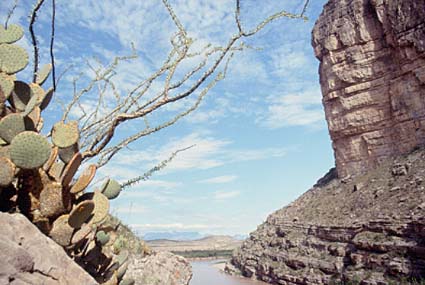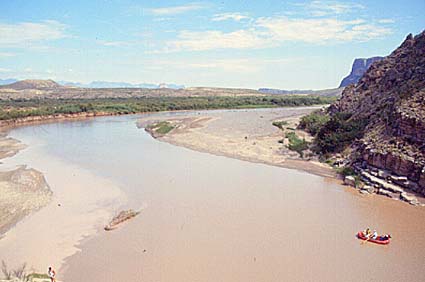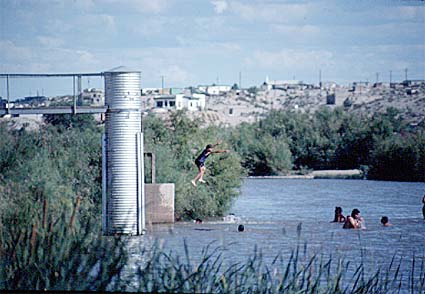|

The Rio Grande north of Elephant Butte reservoir has a very high silt load.Location: 26N 97W (North America); length: 3,000 kilometres (1900 miles); drainage basin: 450,000 square kilometres (170,000 square miles). The Rio Grande (Spanish = large river), the fifth longest river in North America, flows southeast from Pole Creek Mountain in the Rocky Mountains in southern Colorado, forms the border between Texas and Mexico, and finally enters the Gulf of Mexico. While in Colorado, the river rapidly grows in size as it cuts a spectacular route eastward across the southern part of the Sangre de Christos Range. At Alamosa, the first major settlement built at a crossing point of the river, the Rio Grande reaches more open land and turns south, following the grain of the mountain ranges.
White-water rafting on the upper Rio Grande.As it flows through northern New Mexico the Rio Grande flows across bands of horizontally bedded rock of the North Mexico Plateau and it is entrenched into a spectacular gorge. For this reason few settlements lie beside the river. South of Santa Fe, the river flows out onto the plains to the east of the Rockies and its flood plain widens dramatically.
Elephant Butte reservoir on the Rio Grande.For much of its course, the Rio Grande flows through one of the most arid parts of the North American continent and receives water from few tributaries. The most important tributary of the lower part of the river is the Pecos River

The Rio Grande at Big Bend.

The Rio Grande at Big Bend.
The natural flow is often greatly reduced as farmers take water for irrigation. Major reservoirs on the river include those behind the Elephant Butte and Caballo dams in New Mexico and the International Amistad Reservoir on the Texas/Mexico border. The reservoirs are also used for recreation, hydro-electric power and flood control purposes. The Rio Grande is shallow for most of its course and carries a high silt sediment load. It cannot be used for navigation. The major cities on the river include Albuquerque and El Paso. The most spectacular section of the river is now part of Big Bend National Park. Here, where the river cuts a spectacular gorge through the land, the wild arid landscape is preserved. The Rio Grande is one of the major illegal crossing points for Mexicans wanting to get to the United States. They ford the river in their thousands, mostly at night. Because they get wet in the process, these illegal immigrants are nicknamed 'wetbacks'. 
The Rio Grande at El Paso. The picture looks toward Mexico. |